




 |
 |
 |
 |
 |
DEVELOPMENT |
ONLINE
PROJECTS |
|||||
| MDF Board | |
This image of sea & whales was mainly created with a large domestic iron but a hot air gun was also used (in the other hand) to help provide heat to enable the long sweeping strokes to be made fluidly. The base is MDF board and clear wax was applied first. It can pay to seal the board using 70%PVA glue + 30% water. This lessens the amount of wax that would be absorbed on unsealed surfaces. |
|
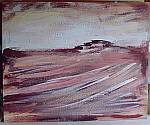 |
Another MDF board, but this time painted with cold brushes that took molten wax colour from a muffin tin palette placed on top of a hotplate. Hot air was used to apply an initial sealing coat of clear wax that was allowed to soak into the board. This provided a strong key for the cold brush application of the coloured waxes. |
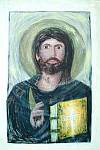 |
Yet another panel of MDF board - this one is more than a meter tall and as above, a hot air gun was used to seal the board with clear wax to improve the adhesion of the coloured waxes applied by cold hogs hair brushes from a hot palette. Smaller detailed areas were done with a finer brush, using an upturned iron, hand held, as a palette that could be brought almost to the place of work. The wax stayed molten for longer this way. |
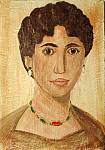 |
Based on a Fayum portrait, this lady of Fayum is painted onto plywood, using hot air to create a clear wax coating initially, providing a better key. Hot air could also be used to facilitate the longer brush strokes, thus extending the time taken before the wax congeals then solidifies. The stylus brush, which is heated metal fibers, was used to do some of the finer work and hair texturing. |
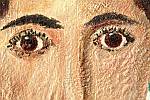 |
Just a closer look at the textures that develop when cold brushes are used to apply coloured wax. As it builds up in depth, and especially when the wax is not over-hot, this grainy texture becomes very evident. |
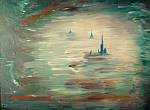 |
Another 4 foot wood piece, but this time the complete background was done with blown hot air work. Due to the thickness of the MDF board it can be quite a slow process to get the wax to move because the board itself needs to get hot enough to facilitate the melting of the wax colours. Details were added afterwards with the stylus drawing tip. |
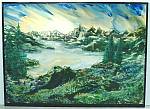 |
The support is regular encaustic art card, but after creation this piece has been mounted onto MDF board to ensure it remains rigid. The sky area is a hot air blown zone. Blowing the lighter colours out and up over the darker ones creates a light that is not achievable in any other way. |
| Stretch Canvas | |
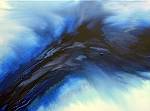 |
Stretch canvas can be used very effectively for hot air blown work. This piece is created exclusively with the hot air gun, although some of the wax was applied by dribbling off the iron. The wax colours were crayon melted onto the canvas first to ensure every part was touched by wax. This helps the flow. Then more colour was dribbled on and blown out into their final form. An exploration of cool colour. |
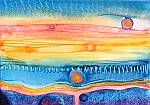 |
A small canvas that was worked with the hot air providing solvency for melt crayoning. The colours were then wiped and blended with old tee shirt fabric. The details were added afterwards with a stylus drawing tip. |
 |
This started as an exercise in use of warm colours. Hot air provided the working solvency but a flexible rectangular filling knife (from any good DIY shop) was the main tool. It was loaded with wax from puddles first melted onto a hotplate. It was a totally spontaneous piece of work with nothing but the palette of colours chosen prior to the first placement of the wax colour. It took about an hour or so to create, but is one of the best canvas pieces I (Michael Bossom) have done. |
 |
In the same series, this tall canvas was inspired by a photo of some local slate cliffs. The colouration was drawn from that photo, but the forms took on a life of their own as it all developed. The central white area was blown, blending with the yellow brown. As it all got a bit muddled at times the outer forms were added almost at the end of the working time. These were direct melt crayoning with the blocks, using the hot air to make the canvas heated and receptive. |
 |
From another series (the "I am" set) this is called "I am Flesh Blood and Light". The background and figure were created using the upturned iron as a heated palette for some old tee shirt fabric. The fabric was made into a pad over a finger, then dipped in the molten colour and smeared onto the canvas which was being warmed by the hot air gun. The figure was added in the same manner, then the light beams created by wiping out some of the wax then adding further white or light colours over. Finally the "tree" foreground details were added by melt crayoning them in directly. |
 |
A small rigid card panel, faced with slick non-absorbent paper surface (line board) is the support for this heavily impasto nude figure. A life drawing was made, then adapted for this piece. A whole host of approaches were explored at this time, including smearing congealing wax onto the background before any coloured wax paint was added. The hot air gun helped provide heat and solvency at different stages in the making of this. It was created to show a variety of encaustic at the Art Materials Exhibition - Islington - London 1992 |
| Abstracts | |
 |
Another small piece of line board (slick paper facing on rigid thick card) is the support for this interesting piece. It is an exploration of mixing various waxes. It was created as an abstract using just the hot air gun to melt and meld the waxes that had been applied using the iron to dribble, etc. What is interesting are the way in which the imagination finds faces, several faces actually. The cloudy looking wax is a mixture of microcrystalline waxes, some of which had quite noticeable shrinkage as they cooled - this added to the result! |
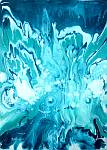 |
One of those aluminum printers plates. Wax colour was applied in a variety of ways with the iron and some drops were landed into the molten wax during working with the hot air gun. The main thing here is that the metal remains hot enough to stop the wax setting, so the whole thing is a liquid sheet. Very fluid and not so very controllable. But results are again interesting and offer differing opportunities for the creative artist. |
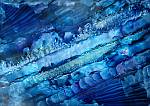 |
A large A1 sized card was used in this abstract exercise that was blown using just a hair dryer at full heat and full blast with a restriction nozzle in place. Wax colours were initially placed in rough position and direction using the iron. the result was a pleasing visually textured work, and was displayed with all the edges becoming the top at some point or other. |
 |
"Parrots in the Chinese Summer" seemed an apt title for this carnival of flamboyant shooting colour. The blowing was with a hair dryer on full settings for everything! Exactly how the colours were placed or how it all started has been forgotten, but in creative artwork with encaustic wax that is often the way. The point is to experience the present moment to the full, not struggling to draw or paint something previously conceived of but moving in the presence of the emerging changing manifestation - art as in being. |
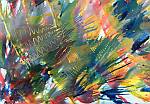 |
A very similar but less enjoyed piece than the one above, this flurry of colour is again hair dryer work with everything set at full on! |
 |
Yet another hair dryer piece, only this time it is a small scale card and the air blast has remained centered. The resulting concentric form has been exaggerated and enhanced by everything else that was done, mostly with either the stylus or a scribing tool. The iron could have been used for the radial straight line marking too. |
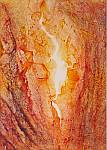 |
This A4 piece is again mostly blown with the hair dryer, simply because the level of heat required was minimal. Much of the wax colour was initially crayoned on cold, then heat and blasting air were used to move this colour around slightly. The inner white "crack" was specifically created by removing wax through scraping and buffing of that area with small disposable "cotton buds". There are some interesting figurative aspects to this piece, which is titled "Break Through" ; relating to a change of consciousness. |
| Flowers | |
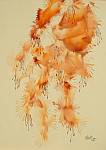 |
"Blowing flowers" is one of the effects many people have been captivated by over many years. In this line board piece the wax colours were first placed as a collection of drops or several spots placed together in a line series. The hair dryer was then used to initially blow out the flower forms that can be seen with the characteristic streaming trails. A hot air gun was used to meld the upper area into a more cohesive part of this image. Stamens were added with the stylus. There are many approaches to flower blowing! |
| This piece is featured in the Project Book and introduces the idea of blowing flowers. Several spots of wax are dripped into positions on the card (A4) then blown out using either a hot air gun (softer outer edges & more "blobby" flowers) or a hair dryer (streaming outer forms, more like a bursting firework). Foliage is added using the iron or stylus if so desired. | |
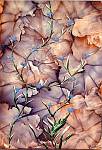 |
An A5 greeting card design created by first covering the card with wax colour using the iron, then employing a hair dryer to blow the patterns into that wax. * Many hair dryers have internal strengthening pieces, often in the form of an equal cross, visible just inside the mouth of the air tube. As the air comes out and with the end of the hair dryer just about 10mm off the card, this cross form imprints because the air has to split to move out around it in its escape from the tube. The line and spot details were added at the end using a stylus. |
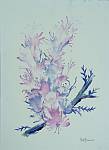 |
Another flower image, the sort that proved very marketable
as home decor. This one is done on line board (slick paper covering rigid
card) and the initial blobs were placed with the iron tip. These were then
blown out in to the flower forms using a hot air gun with restrictor. *
Notice how the bloom edges are much more fluid than the image below (fantasy)
which is a hair dryer result. The heavier branch and other details were added with iron and stylus. |
| Fantasy Work | |
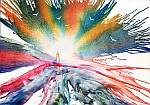 |
Entitled "Forgiveness", this piece is a hair dryer blowing. First the top "sky" area was blown out from a central collection of wax colour, then the iron used to add in the foreground, trying to maintain a complementary feeling, yet create a contrast of cold lower and warm upper. The figure was added by the tip of the iron and the birds are scraped out with the scribing tool. |
 |
Also featured in the Project Book this sea scrape was created to demonstrate how a sky can be textured and charactered by use of a hair dryer. Notice the turbulence that has resulted as the outer expanding edge of the moving wax cools to setting point. The concentric ring patterns are similar. For smooth skies you would need to use a hot air gun. |
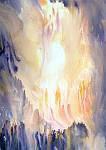 |
"I am Heart of Fire" is another in the "I am" series from 2005. It is blown entirely with the hot air gun and was pre-conceived from the point of view of colouration and type of image. Suggestion of people, strong light, movement, and yet it can be seen in an entirely different perspective and scale too.
|
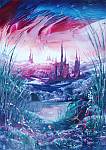 |
The sky in this fantasy image (A2) was first created by drag coating the card on a hotplate,the immediately blowing that molten coating with a hot air gun to enhance the initial coating. Note: The hot air gun is a useful tool for removing hairs or dust you discover have become embedded or trapped in your work - see the tip here |
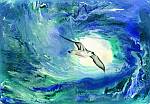 |
"Bird Swirl" is one of the original exploratory pieces of swirl creation and portrays an arctic tern that flies from one pole to the other as the seasons change. Created on line board with a combination of various waxes, the tern was draw with the aid of a reference book. This was a flagship image for encaustic art all through the 1990's & early 2000's |
| A powerful fantasy that was a testing of the now discontinued "AartZ Wax" colours. The expanding swirl amphitheater was created with the dragon detail already pre-conceived. The strangest thing was that the face just above the to the right of the end of its tail was a totally natural occurrence that only became noticed later. Strange how this magical medium so connected to fire can reveal such things. | |
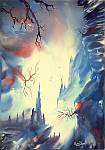 |
A typical hot air blown background, developed with the stylus using very simple vertical castle spires as "depth markers". The darker details around the edges again emphasis the illusion of depth (where there is really only a flat card). Such light bursting images are always popular and make good home decor if you are looking to sell your encaustic's to make a bit of money! |
 |
This unicorn fantasy typifies the elements within that style of genre. Moody hot air blown skies, mystical structures, castles inspiring (or not), dark stones speaking of the earths hidden forces and the unicorn, holding a sense of direction and stability in its unwavering reality. |
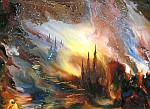 |
The first hot air image filmed for the initial Encaustic Art "Simple to start... ... exciting to explore" video in 1991. This image stood the test of time and remains as true in colour today as the moment it was created. Another beauty of encaustic art colours ; they hold the pigments true hue. See this image develop on the swirl creation page. |
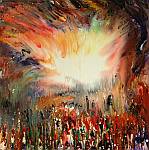 |
... and finally a classic image entitled "The Gathering" which is another AartZ Wax work. Made using the iron to dribble the wax colour onto a clear wax coated line board, then blown in the swirl style with a hot air gun. The lower area, that brings to mind a huge crowd of people, is in part a while set of slightly melted blobs that have been encouraged to dribble down the board then back up again just a little. Hope you enjoyed this section. |
|